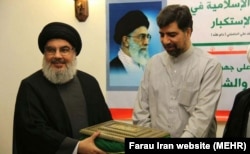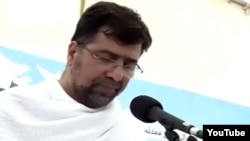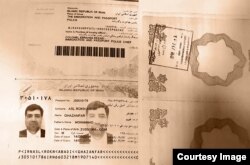Radiofarda – Four years ago, on September 24, 2015, an unfortunate event claimed the lives of more than 2,000 Muslims during the annual Islamic pilgrimage of Hajj. During the “deadliest Hajj in history”, people were killed in Mina, a neighbourhood of Mecca, as a result of a stampede.
Among the pilgrims was an Iranian diplomat/operative who served for years in Lebanon and was slated to be sent to a mission in Yemen soon. There were also several other figures connected with Iran’s Revolutionary Guards who died in the stampede, but one stood out.

Ghazanfar Roknabadi, a trusted man of the Islamic Republic’s leader Ayatollah Ali Khamenei, a close friend to Lebanese Hezbollah leader Hassan Nasrollah and a person who was supposed to play a role in the war-torn Yemen, was killed in Mina Stampede. However, his death raised many unanswered questions.
According to the Saudi news channel Al-Arabiya, Roknabadi was “a safe box of Hezbollah and Iranian missiles’ secrets in Lebanon.”
Here is the story of the diplomat’s disappearance after the stampede, the return of his dead body and everything that makes it mysterious.
Who was Ghazanfar Roknabadi?
Ghazanfar Roknabadi was 13 years old at the time of the 1979 Islamic revolution in Iran. While he was not among the first generation of the new regime’s diplomats, Roknabadi soon proved himself as an asset for the Islamic Republic’s Ministry of Foreign Affairs.
As a Basiji (a member of Mobilization Resistance Force) student, he graduated from Imam Sadegh University in Iran. The university is well-known for preparing trusted figures for the Islamic regime in Iran.
“Imam Sadegh University has been established by the regime’s authorities to train faithful people for the highest positions in Iran. Students are brainwashed with the Islamic Revolution’s ideology,” Abbas Khosravi Farsani, a US-based Iranian researcher who had been expelled from the university for criticizing the Islamic Republic’s leadership, told Radio Farda recently.
Nevertheless, Roknabadi joined the Ministry of Foreign Affairs in 1990 immediately after receiving an MA degree in Political Science. In 1991, he was sent to Egypt for a temporary mission as a junior diplomat. His first long-term mission started in March 1994 in Lebanon. He spent four and a half years in Beirut.

Serving five years in Syria from 2002 to 2007, made Roknabadi even more experienced in Middle East affairs. This propelled him to the post of ambassador to Lebanon in 2010.
Roknabadi was an important link between top Iranian leaders and Lebanon’s Hezbollah. He was among a few trusted figures in the Ministry of Foreign Affairs who were directly linked to the Supreme Leader’s office. He even used to work at Khamenei’s office while he was stationed in Iran.
On November 19, 2013, a bomb exploded in front of the Iranian embassy in Beirut. Roknabadi was the prime target but he was not among other embassy personnel at that time. The ambassador survived but the head of his security team, the embassy’s cultural attaché, and an Iranian diplomat’s wife were killed along with 20 other victims. Roknabadi’s protection team who were highly trained members of Hezbollah protected him from other assassination attempts too.
One year before the Mina incident, Roknabadi’s mission in Lebanon ended. He went back to Tehran and was preparing to go to Yemen. Only six months before that, the Arab Coalition led by Saudis was formed to combat Iranian backed Houthis in Yemen. Therefore, Yemen was becoming the latest arena for an Iranian-Saudi proxy war in the region.
Roknabadi, from disappearance to death in Mecca
The Mina stampede happened in the morning of September 24. It didn’t take long for Iranian officials to start worrying about the fate of their key operative in a country which had a strong opposition to Roknabadi’s missions in the Middle East. Soon they found a real reason to be worried.
Only four days after the Mina stampede, Saudi officials said no one with the name of Ghazanfar Roknabadi has entered the kingdom to attend the 2015 hajj.
Without delay, the spokesperson of Iranian Ministry of Foreign Affairs published a copy of Roknabadi’s passport while the exit stamp from an Iranian airport was seen on one of its pages. Ghazanfar Roknabadi had in fact entered Saudi Arabia on September 9, 2015, with a non-diplomatic passport, which incidentally was too early for the Hajj pilgrimage. If this was for a purpose other than than performing the Hajj, no revelations have ever been made.

At the same time, Iranian state TV published footage showing Roknabadi delivering a speech in Mecca a day before the Mina stampede. The speech was on an event called Disavowal of Polytheists in Hajj. Almost three decades earlier, in 1987, a clash between Shia pilgrim demonstrators and the Saudi security forces in Mecca led to the deaths of over 400 people, mostly Iranian pilgrims. Since then, Saudis security forces monitor the event closely. Anyhow, Saudi media were denying the presence of Roknabadi on their soil quoting the country’s officials.
On October 3, 2015, Iranian semi-official Mehr News Agency published a report indicating that some Iranian pilgrims and healthcare practitioners had seen Roknabadi alive but injured before being transferred by ambulance. Roknabadi’s daughter later confirmed that an employee of the Iranian Hajj and Pilgrimage Organization, Hosseini Borazjani had himself transferred her father to an ambulance, but Saudi authorities had not allowed him go with Roknabadi to hospital.
Giving the fact that Roknabadi was at the heart of some important events in the Middle East, Mehr News Agency highlighted the importance of Roknabadi and suggested that the diplomat might have been kidnapped by security forces in Saudi Arabia.
Before the article was published, a former Iranian Foreign Minister Ali Akbar Velayati, who is still a high-ranking politician close to the Iranian Supreme Leader, told reporters that the disappearance of Iranian officials in Saudi Arabia during the stampede is “suspicious.”
The destiny of Roknabadi was still unknown when Saudi officials suggested that they want to bury the victims of the incident in the kingdom’s cemeteries.
Iran harshly reacted to the suggestion. Iranian Supreme Leader Ali Khamenei promised a “hard and violent” reaction by Iran if the Saudis do not do “whatever they must regarding the corpses.”
Mohammad Ali Jafari, then the commander-in-chief of the Islamic Revolutionary Guard Corps, said IRGC is ready for “an immediate and violent reaction” to make Saudis pay a price for the Mina stampede.

An Iranian Foreign Ministry official announced that the Islamic Republic wants to have all the corpses and won’t agree with burying them in Saudi Arabia.
It took two months until Roknabadi’s death was officially announced. On November 25, 2015, Roknabadi’s daughter confirmed her father’s death.
After all, the diplomat’s corpse lacked brain, kidneys, lungs, spleen, heart and some other organs.
Some even argued that the removal of body parts was done to make it difficult for Iranian forensic investigators to find out the reason and exact date of Roknabadi’s death.
While an Iranian foreign ministry official said the diplomat died because of heat and thirst, his family are not happy with the story.
Unsatisfied family, silent officials
In the aforementioned interview with Mehr, Roknabadi’s wife and daughter raised scepticism about his death. They had reasons to believe the death was suspicious. According to them, some people who previously claimed they saw Roknabadi alive with a broken leg, denied their initial testimony after a few days.
According to Roknabadi’s family, a witness who insisted seeing Roknabadi alive, testified that only the diplomat’s leg was hurt with no damage to his upper body, and he could move his hands before being transferred to an ambulance.
“We don’t believe the theory of my father’s death on the first day of Mina stampede. We are sure that our father was martyred later. They (Saudis) just wanted to buy some time to make the work (forensics) impossible [to hide the reason for his death],” Roknabadi’s daughter told Mehr News Agency, “my father was the only person whose body organs were removed.”
Ghazanfar Roknabadi’s brother, Morteza, claimed, “most probably he was kidnapped and received some injections to make him confess. That’s why they removed his body organs.”
Still A mystery
On January 3, 2016, Saudi Arabia’s foreign ministry announced that it would cut diplomatic ties with Iran due to a mob attack on its embassy in Tehran, which police allowed to happen. This put an end to the family’s hope for following up the case with Saudi authorities. The family also claims there is no political will in Iran to pursue the case.
However, there are still many unanswered questions. Why Roknabadi went to Saudi Arabia two weeks before hajj? Why there are a a dozen high ranking IRGC commanders and Iranian officials among the victims? What was the reason behind Saudi Arabia’s initial denial of Roknabadi’s presence in the country while he was a well-known figure to them? Why they removed his organs? Why Iranians prefer to be silent despite their first aggressive reactions?
These days, with the rise of tensions with Saudi and Iranian regimes, and at the midst of UN General Assembly’s hot debates, Roknabadi’s fate is the latest thing two countries might want to bring it up. However, the mystery is still unsolved.
- Kambiz GhafouriKambiz Ghafouri is a journalist at Radio Farda. His focuses Politics, Society and International Relations.
 Shabtabnews In this dark night, I have lost my way – Arise from a corner, oh you the star of guidance.
Shabtabnews In this dark night, I have lost my way – Arise from a corner, oh you the star of guidance.


